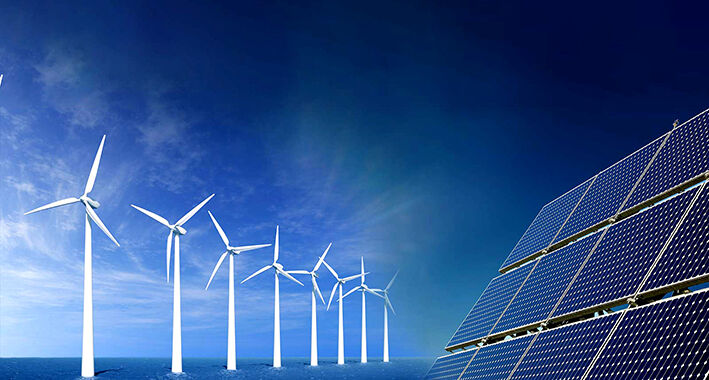The UAE has announced a comprehensive carbon reduction plan for up to 2050 in a bid to bring its carbon emissions down to zero. According to Dubai ruler Mohammed bin Rashid Al Maktoum, the UAE would need to invest about $165 billion in clean and renewable energies up to 2050 to realize its goal. For the UAE, investment in renewables would help enhance the economic growth rate, much less create job opportunities. That can also become a major source of income for this country in the future to reduce its economic dependence on fossil energy sales.
Renewables
Furthermore, the advancement of plans related to increasing the role and share of renewables in the UAE’s energy mix, along with the use of the nuclear power plant and the development of a program for the use of hydrogen, will improve the political position of the UAE in global equations and international organizations as in a region that is still dominated by fossil fuels, the UAE is trying to show itself as one of the leading countries in climate change.
Accordingly, the UAE is the first country in the Middle East to sign the Paris Agreement. In accordance with the 2015 Paris Climate Treaty, the UAE has committed to use a combination of solar, nuclear, and other energies to replace fossil fuels with renewables in the future. However, the UAE’s renewable energy program is not only limited to the country’s domestic consumption; rather, it aims to become the first power in the region in this sector.
According to the UAE’s Energy Vision 2050, 44% of the country’s energy needs should be supplied by renewable sources. For this purpose, the UAE has invested $160 billion in the infrastructure of renewable energy use. For power generation from solar energy, the UAE is one of the leading countries in the region, with the production of 140 MW of electricity per year, standing third in the production of concentrated solar energy in the world.
The UAE’s most significant renewable energy project is Mohammed bin Rashid Al Maktoum Solar Park. It is a solar park spread over a total area of 77 square kilometers in Saih al-Dahal, about 50 kilometers south of the city of Dubai. It is one of the world’s largest renewable projects based on an independent power producer (IPP) model. Besides solar farms using PV technology, the long-term project will also include concentrating solar power (CSP). The total capacity of the entire project is planned to reach more than 4,000 MW.
The 200-megawatt second phase of the project attracted global attention as the winning bid of the tender set a new record-low tariff. This is about 20% lower than any previous, unsubsidized power purchase agreement (PPA) the world has seen before. The PPA is set to a 25-year time frame.
The plant was implemented by the Dubai Electricity and Water Authority (DEWA). The first phase of the project was commissioned on 22 October 2013. At the end of 2020, the solar PV complex reached a generating capacity of 1.013 GW to reach 5GW by 2030. Currently the 4th (700 MW CSP + 250 MW PV) and 5th phase (900 MW PV) are under construction. Thanks to a storage capacity of up to 15 hours, the plant can produce power day and night.
In addition, the UAE plans to establish the tallest concentrated solar energy tower in the world and double its solar energy production. This tower with a height of about 260 meters, almost 60 meters shorter than the Eiffel Tower, is supposed to use about 70,000 heliostats, which are like mirrors to reflect the rays of sunlight and convert it into thermal energy and store it for about 15 hours.
Challenges ahead
Although the UAE government’s determination and decision to reduce the role of fossil fuels in the country’s economy is important, Abu Dhabi is also facing challenges in advancing its plans.
The first challenge is the transition from fossil energy consumption to clean energy. The UAE, a country of ten million, emits very big amounts of carbon dioxide in the world. Australia and the United States, it is responsible for one of the highest levels of GHG emissions in the world. For this reason, despite investing more than $40 billion in clean energies in recent years, the UAE still has one of the highest levels of carbon emissions. Major industrial countries are facing many challenges to achieve the goal of net zero carbon emissions. Because the gradual change of the energy mix in industrial fields and also the lifestyle of people to use less fossil energy is a time-consuming process. Therefore, the UAE will not face an easy task in energy transition.
The second challenge the UAE is faced with in renewable energy generation is foreign investment attraction. The UAE intends to generate 70% of its electricity from renewables by 2050, which would require foreign investment. There are legal obstacles; however, by deregulating the energy market, the UAE intends to engage more players in energy production.
The third challenge to the UAE’s renewable energy generation is the concentration of renewable generation in Dubai. While Dubai is going its way towards more solar energy and less carbon, other UAE areas still heavily depend on traditional sources of energy. These areas are also taking great strides to pave the way towards the future through strategic investment.
Overall, despite the UAE’s efforts to diversify its energy mix, oil and gas exports remain the main pillar of its economy, accounting for 30% of its gross national product (GNP). Undoubtedly, it would be tough for the UAE to reduce fossil energy production at a time when renewables require investment. The UAE would need to generate fossil energies both for its economic management and for attracting investment to advance renewable energy macro-projects.
Iran Petroleum


Your Comment